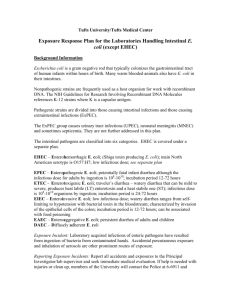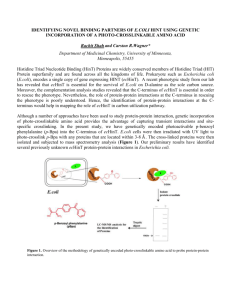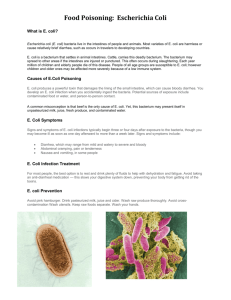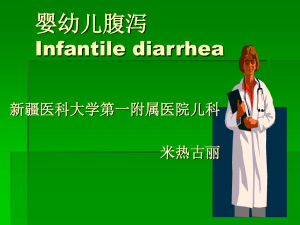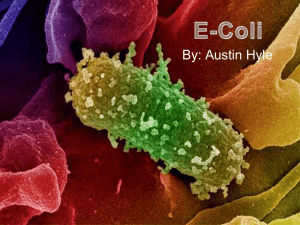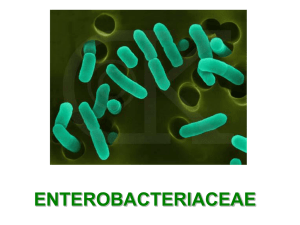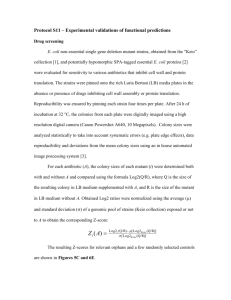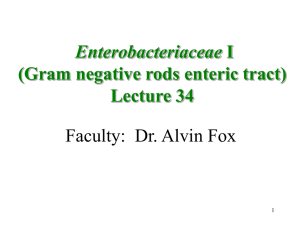Escherichia coli
advertisement
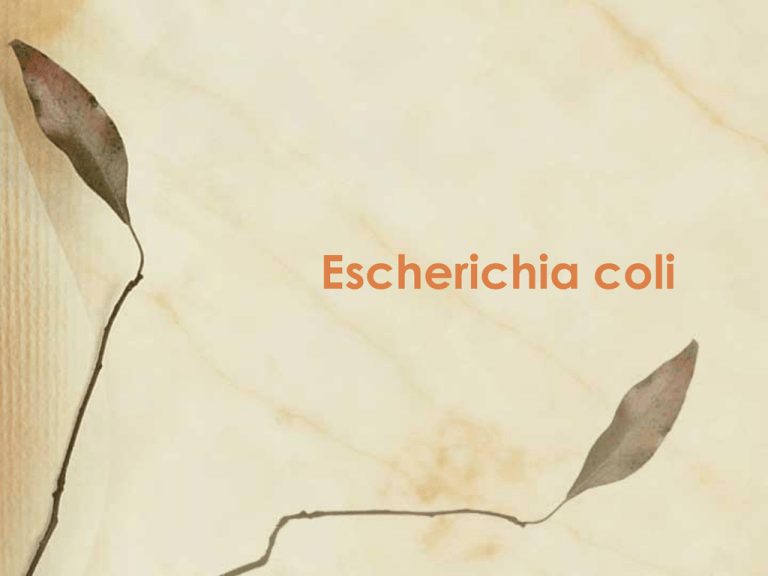
Escherichia coli Escherichia coli Named for Theodor Escherich a German physician (1885) Normal flora of the mouth and intestine. Protects the intestinal tract from bacterial infection. Produces small amounts of vitamins B12 and K Colonizes newborns GI tract within hours after birth. Properties: Gram-negative Facultative short rod. anaerobe Member of the Enterobacteriaceae family. It is present normally in high concentrations (108/g) in normal human feces. Motile and ferments lactose. It has three antigens 1. O, or cell wall, antigen 2. H, or flagellar, antigen 3. K, or capsular, antigen. Diseases in general: Urinary tract infection (UTI), Sepsis, Neonatal meningitis, and "traveler's diarrhea" are most common. E.coli Pathogenesis: Reservoir: Humans and animals( cattle). The source of E. coli that causes UTI is the patient's own colonic flora. The source of E. coli that causes neonatal meningitis is the mother's birth canal. E. coli that causes traveler's diarrhea is acquired by ingestion of contaminated food or water. It causes pathogenesis by. I. Pili and capsule II. Endotoxin. III. Three exotoxins (enterotoxins). 1. Labile toxin 2. Stable toxin 3. Verotoxin that causes bloody diarrhea and hemolytic-uremic syndrome. A. B. 1. Clinical disease: Intestinal: Caused by four different strains Enteropathogenic E coli Watery diarrhea primarily in infants by endotoxin. Enterotoxigenic Escherichia Coli Causes traveler's diarrhea in all age-groups. Two enterotoxins are responsible for traveler diarrhea. The heat-labile toxin (LT) stimulates adenylate cyclase. C. It in turn causes increased cyclic AMP which causes outflow of chloride ions and water, resulting in diarrhea. The heat-stable toxin (ST) causes diarrhea by stimulating guanylate cyclase. Enterohemorrhagic Escherichia Coli Causes Hemorrhagic Colitis and Hemolytic-Uremic Syndrome. Verotoxin (a cytotoxin) responsible for hemorrhagic colitis and hemolytic uremic syndrome. Hemorrhagic colitis: A severe form of bloody diarrohea. Hemolytic uremic syndrome. A potentially life-threatening acute renal failure. D. Enteroinvasive E. coil Cause a dysentery-like syndrome with fever and bloody stools. Extraintestinal disease: 1. UTI. E. coil is the most common cause of cystitis and pyelonephritis. Women are particularly at risk for infection. 2. Neonatal meningitis: E. coli is a major cause of disease occurring within the first month of life. 3. The K (capsular) antigen is particularly associated. Nosocomial (hospital-acquired) infections: These include sepsis endotoxic shock, and pneumonia. 1. 2. Laboratory Diagnosis: Specimens suspected of containing E. coli, are grown on A blood agar plate and On a differential medium, such as EMB agar or MacConkey's agar. E. coli, which ferments lactose, forms pink colonies, whereas lactose-negative organisms are colorless. Pure culture of E.coli. Detection from stool is difficult but easier from specimens like CSF and urine



